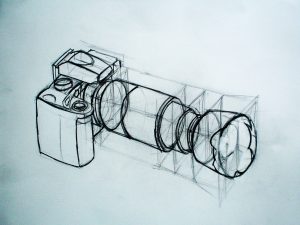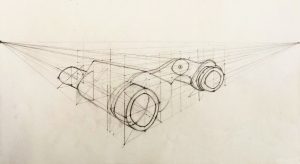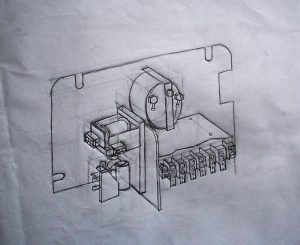Contents
Overview:
To draw a complex object in perspective through analyzing its component geometric shapes and their relationship to each other
Due Date: xxxx
Instructions:

- Choose a complex object that is made up of geometric curved and straight-edge shapes at different angles to each other. Do NOT choose organic objects like flowers, people, animals or shells.
- Make many FAST thumbnail sketches to determine the best vantage point for drawing this object in terms of showing its important features and creating a strong design on the page.
- Make as many 2-point perspective free-hand quick sketches as necessary to understand the component parts to this object:
- Draw the object as it looks to your eyes;
- Lightly draw guideline boxes around component parts;
- Decide relative proportions of these component parts.
- Decide relative locations of these component parts.
- On 14×17 inch white paper, draw this object accurately in 2-point perspective.
- Lightly draw guideline boxes, lines to vanishing points, and the X to help find visual mid-points of sides.
- Vary line pressure to help create visual clarity and interesting design.
- Draw invisibles with light, dotted lines.
- Consider scale and page placement for a strong overall design.
- Upload the final drawing, all thumbnail sketches, and a photo of your actual object to the Complex Drawings tab housed under Student Posts in OpenLab.

Learning Objectives:
- To be able to realistically depict an actual complex object using two-point perspective
- To understand how a complex object can be subdivided into its simple geometric components, relative locations of features and general proportion, so as to believably render it from any direction
- To further explore the seeming distortions created from foreshortening
- To further sharpen design skills
Resources:
Click HERE for the following resources:
- Step-by-step drawings with written annotation

Checklist:
- Is your object made of numerous geometric shapes whose central axes are at different angles?
- Have you drawn thumbnail sketches from sight and then analyzed component parts in terms of their relative sizes and locations?
- Have you drawn an X to find visual centers?
- Have you included guideline boxes and lines to vanishing points?
- Have you dotted invisibles?
- Have you paid attention to design in terms of scale, page placement, positive/negative shapes, etc?
- Have you uploaded the final drawing, all thumbnail sketches, and a photo of your actual object to the Complex Drawings tab housed under Student Posts in OpenLab?



